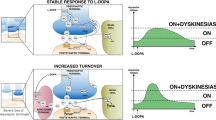Abstract
Long-term levodopa therapy in patients with Parkinson’s disease (PD) is associated with motor complications including motor fluctuations (MF) and levodopa-induced dyskinesias (LID). The time to appearance of MF and LID is apparently related to both the timing and the duration of levodopa therapy, but is highly variable. We performed a retrospective analysis of all levodopa-treated PD patients to explore the effect of time from PD onset to levodopa initiation on time to MF or LID. We used a Cox multivariate regression model after stratifying patients into four quartiles, according to the time to levodopa initiation. Data from 170 PD patients (117 males, age at onset: 65.1 ± 11.6 years, time to levodopa treatment: 23.8 ± 28.4 months) was included in the analysis. Early levodopa administration was associated with a shorter time from diagnosis to both MF (p < 0.001) and LID (p = 0.001). The hazard ratio to develop MF and LID from the time of PD diagnosis was 2.48 (p < 0.001) and 2.71 (p = 0.002), respectively. In our population, we found that delaying levodopa administration was associated with a longer time to the appearance of motor complications after diagnosis. While disease duration is the most important determinant of the onset of motor complications, delaying levodopa could prolong the ‘complication-free’ period.



Similar content being viewed by others
References
Ahlskog JE, Muenter MD (2001) Frequency of levodopa-related dyskinesias and motor fluctuations as estimated from the cumulative literature. Mov Disord 16(3):448–458
Cilia R, Akpalu A, Sarfo FS, Cham M, Amboni M, Cereda E, Fabbri M, Adjei P, Akassi J, Bonetti A, Pezzoli G (2014) The modern pre-levodopa era of Parkinson’s disease: insights into motor complications from sub-Saharan Africa. Brain 137(Pt 10):2731–2742
Cotzias GC, Papavasiliou PS, Gellene R (1968) Experimental treatment of parkinsonism with L-Dopa. Neurology 18(3):276–277
Fahn S, Oakes D, Shoulson I, Kieburtz K, Rudolph A, Lang A, Olanow CW, Tanner C, Marek K, Marek K; Parkinson Study Group (2004) Levodopa and the progression of Parkinson’s disease. N Engl J Med 351(24):2498–2508
Grandas F, Galiano ML, Tabernero C (1999) Risk factors for levodopa-induced dyskinesias in Parkinson’s disease. J Neurol 246(12):1127–1133
Hassin-Baer S, Molchadski I, Cohen OS, Nitzan Z, Efrati L, Tunkel O, Kozlova E, Korczyn AD (2011) Gender effect on time to levodopa-induced dyskinesias. J Neurol 258(11):2048–2053
Holloway RG, Shoulson I, Fahn S, Kieburtz K, Lang A, Marek K, McDermott M, Seibyl J, Weiner W, Musch B, Kamp C, Welsh M, Shinaman A, Pahwa R, Barclay L, Hubble J, LeWitt P, Miyasaki J, Suchowersky O, Stacy M, Russell DS, Ford B, Hammerstad J, Riley D, Standaert D, Wooten F, Factor S, Jankovic J, Atassi F, Kurlan R, Panisset M, Rajput A, Rodnitzky R, Shults C, Petsinger G, Waters C, Pfeiffer R, Biglan K, Borchert L, Montgomery A, Sutherland L, Weeks C, DeAngelis M, Sime E, Wood S, Pantella C, Harrigan M, Fussell B, Dillon S, Alexander-Brown B, Rainey P, Tennis M, Rost-Ruffner E, Brown D, Evans S, Berry D, Hall J, Shirley T, Dobson J, Fontaine D, Pfeiffer B, Brocht A, Bennett S, Daigneault S, Hodgeman K, O’Connell C, Ross T, Richard K, Watts A, Parkinson Study Group (2004) Pramipexole vs levodopa as initial treatment for Parkinson disease: a 4-year randomized controlled trial. Arch Neurol 61(7):1044–1053
Horstink M, Tolosa E, Bonuccelli U, Deuschl G, Friedman A, Kanovsky P, Larsen JP, Lees A, Oertel W, Poewe W, Rascol O, Sampaio C, European Federation of Neurological Societies, Movement Disorder Society-European Section. Review of the therapeutic management of Parkinson’s disease (2006) Report of a joint task force of the European Federation of Neurological Societies and the Movement Disorder Society-European Section. Part I: early (uncomplicated) Parkinson’s disease. Eur J Neurol 13(11):1170–1185
Hughes AJ, Daniel SE, Kilford L, Lees AJ (1992) Accuracy of clinical diagnosis of idiopathic Parkinson’s disease: a clinico-pathological study of 100 cases. J Neurol Neurosurg Psychiatry 55:181–184
Katzenschlager R, Head J, Schrag A, Ben-Shlomo Y, Evans A, Lees AJ (2008) Parkinson’s Disease Research Group of the United Kingdom Fourteen year final report of the randomized PDRG-UK trial comparing three initial treatments in PD. Neurology 71:474–480
Oertel WH, Wolters E, Sampaio C, Gimenez-Roldan S, Bergamasco B, Dujardin M, Grosset DG, Arnold G, Leenders KL, Hundemer HP, Lledó A, Wood A, Frewer P, Schwarz J (2006) Pergolide versus levodopa monotherapy in early Parkinson’s disease patients: the PELMOPET study. Mov Disord 21(3):343–353
Parkinson Study Group (2000) Pramipexole vs levodopa as initial treatment for Parkinson disease: a randomized controlled trial. Parkinson Study Group. JAMA 284(15):1931–1938
PD Med Collaborative Group, Gray R, Ives N, Rick C, Patel S, Gray A, Jenkinson C, McIntosh E, Wheatley K, Williams A, Clarke CE (2014) Long-term effectiveness of dopamine agonists and monoamine oxidase B inhibitors compared with levodopa as initial treatment for Parkinson’s disease (PD MED): a large, open-label, pragmatic randomised trial. Lancet 384(9949):1196–1205
Rascol O, Brooks DJ, Korczyn AD, De Deyn PP, Clarke CE, Lang AE (2000) A five-year study of the incidence of dyskinesia in patients with early Parkinson’s 262-6 disease who were treated with ropinirole or levodopa. N Engl J Med 342:1484–1491
Rinne UK, Bracco F, Chouza C, Dupont E, Gershanik O, Marti Masso JF, Montastruc JL, Marsden CD (1998) Early treatment of Parkinson’s disease with cabergoline delays the onset of motor complications. Results of a double-blind levodopa controlled trial. The PKDS009 Study Group. Drugs 55(Suppl 1):23–30
Sharma JC, Bachmann CG, Linazasoro G (2010) Classifying risk factors for dyskinesia in Parkinson’s disease. Parkinsonism Relat Disord 16(8):490–497
Author information
Authors and Affiliations
Corresponding author
Ethics declarations
Ethical approval
This study was approved by the Ethics Committee of the Sheba Medical Center.
Conflict of interest
On behalf of all authors, the corresponding author states that there is no conflict of interest.
Informed consent
Informed written consent was obtained from all individual participants included in the study.
Rights and permissions
About this article
Cite this article
Yahalom, G., Cohen, O.S., Warmann-Alaluf, N. et al. The impact of early versus late levodopa administration. J Neural Transm 124, 471–476 (2017). https://doi.org/10.1007/s00702-016-1669-4
Received:
Accepted:
Published:
Issue Date:
DOI: https://doi.org/10.1007/s00702-016-1669-4




